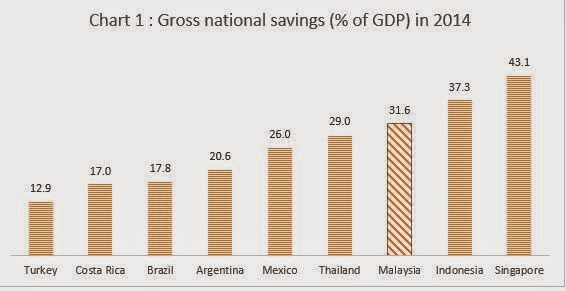Slightly more than four decades
ago, two academics from University Kebangsaan Malaysia published a paper on the
savings rate in Peninsular Malaysia. Drawing from Department of Statistics
(DOS) 1957 Household Budget Survey - the last survey undertaken by the colonial government, they found out that on average, Malaysian
households saved about $19.47 per month, which translated to a savings rate of
nearly 10% of monthly income. Interestingly, they also found out that urban
households saved more - 11% of income compared to rural households (8%), and
Malay households had a higher propensity to save compared to other groups - on
average, Malay households saved 13% of their monthly income compared to 8% in
the case of Chinese households.
Unfortunately, there has not been a study or publication on the pattern of savings among Malaysian households since then. We are thus unable to know whether Malaysians save more or less, and the dynamics of our savings behaviour. What is regularly published is our national savings rate. Latest figures from the International Monetary Fund (IMF) show that Malaysia’s gross national savings, as a percentage of GDP, is 31.6% in 2014, which is higher than the rate charted in other higher middle income countries (Chart 1).
Source: IMF (2014)
Does a high national savings rate
mean that our households also have a high savings rate? The answer is
unfortunately, no. The United Nations
Development Program recently released a report, “Malaysia Human Development Report
[MHDR] 2013 – Redesigning an Inclusive Future,” highlighted the vulnerabilities
of Malaysian households primarily due to a lack of savings. Using data from successive Household Income
Surveys, the report stated that about 88% of Malaysian households reported zero
earnings from precautionary savings [excluding EPF deductions which are known
as compulsory savings]. The report further stated that financial investment
among Malaysians is also quite low – about 57% of Malaysian households reported
zero earnings from investment. The lack of investment is more pronounced among
urban households compared to rural households. On average, 50% of urban
households have no investment, compared to 34% of rural households. There are no differences in the savings rate
among ethnic groups. According to the MHDR “[R]oughly
one out of two Bumiputera, Chinese, and Indians have no immediate liquid
financial assets, making them vulnerable in the event of an income or
employment shock”. Even the figures
for compulsory savings i.e. savings in EPF, paint an equally perturbing
picture. Using EPF data, the MHDR shows that as at 2013, roughly a fifth of
Malaysians who are nearing retirement age have less than RM 20,000 in savings.
Why is this so? Is it because of
lack of financial inclusion? Not necessarily. Data from Bank Negara Malaysia
show that nearly 92% of Malaysians have savings or deposit accounts, which
means that access to basic savings instruments is not an issue. However, when
one looks at investment accounts, different pictures emerge. For instance, half
of the Bumiputera do not have an ASB account, and about two-thirds do not have
accounts with Tabung Haji. The key reason why many Malaysian have low savings
and low financial assets is due to low incomes and salaries. Based on data from
DOS, median monthly salaries and wages per month in 2013 is RM 1,700. This is
not surprising, as only 10.4% of Malaysian workers are degree-holders. Given
the low wages and high cost of living, it is no surprise that many Malaysians
find it hard to set aside some money for savings and investment.
While there are many short-term
measures that can be implemented to alleviate financial constraints of
households, what we need are long-term and sustainable solutions. Khazanah
Research Institute’s inaugural publication “The State of Households” published
early last month aptly describes the solution. A focus on education is a must
as “[A] lack of education of the
overwhelming majority of our workforce is one of the most important causes of our
low wages and low household incomes”. Education in this sense is not only
about acquiring higher educational attainment but equally important is to
ensure financial literacy and awareness, especially among the younger
generations. To reap the benefits of the country’s development in an equitable
and empowering manner, it is essential to adhere to the popular saying that an
investment in education pays the best interest.
by Muhammed Abdul Khalid
[Note : Originally published in Malaysian Business 16 Dec 2014]

No comments:
Post a Comment